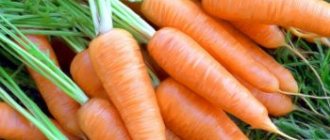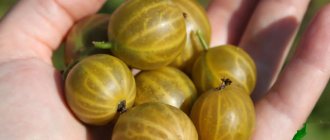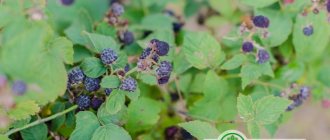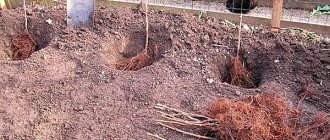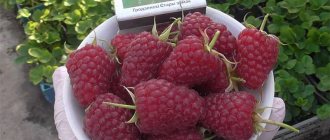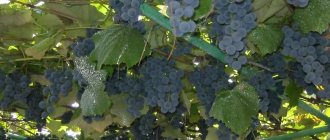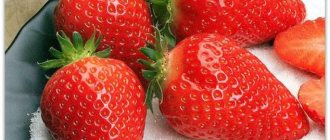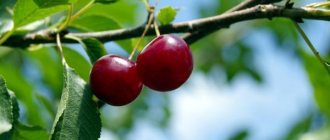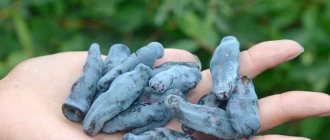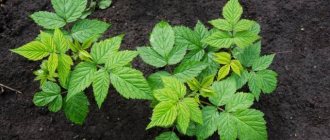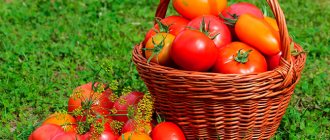How to choose the right remontant raspberries?
It is necessary to understand that each raspberry variety has its own characteristics. Residents of the southern regions have a wide choice, as they have mild winters and plenty of sun. Therefore, this is where most of the producers of this berry are located. However, residents of the Moscow region can also make a choice in favor of one culture or another.
But you need to carefully study some features:
- Age of the bushes. It is recommended to buy annual bushes. They are green.
- Externally, remontant raspberries are no different from ordinary ones. To avoid problems, you should buy planting material only in trusted places.
- Before buying, you should look on the Internet and decide which variety is suitable for a particular region. This will allow you to buy what you need.
- Before purchasing, you need to carefully examine the seedling and make sure that there are no signs of rot or other diseases.
- When choosing a specific subspecies, it is necessary to give preference to frost-resistant ones, since sometimes there are cold winters in Moscow. This was especially demonstrated by the winter of 1942.
Important. Today there are a large number of raspberry varieties. In order not to make a mistake with your choice, it is worth looking at specialized portals to see which varieties are bred in Moscow nurseries. This will significantly narrow the search for the optimal option.
Disease resistant
Raspberries that are resistant to various diseases:
- Polka is a remontant crop, bears fruit before the onset of frost;
- Hercules is a frost-resistant plant with large sweetish berries;
- The pride of Russia is an early-ripening variety that produces a large harvest and can withstand harsh winters;
- Tarusa is a standard crop with large, red, fragrant berries.
Raspberries are a plant that is very sensitive to many diseases. A culture may be resistant to one type of microorganism, but become sick from other microbes or viruses. Resistant to purple spot: Novost Kuzmina, Meteor, Balsam. To Anthracnose: The Shy One, Augustine. Novosti Kuzmina and Phoenix are resistant to powdery mildew. To gray rot: Cumberland, Carnival.
When to plant - spring or autumn?
Today there is no clear answer to this question. Some gardeners prefer to plant this crop in the fall, while others do it in the spring. Both seasons have their merits.
When planting in spring:
- raspberries are better prepared for wintering;
- you can understand how suitable the selected raspberry bushes are for further cultivation;
- the opportunity to get a summer harvest;
- the plant immediately begins active growth.
However, autumn planting also has many advantages, namely:
- saving fertilizers, since less of them are needed to warm up young roots;
- in spring, the crop immediately begins intensive growth without the need for acclimatization;
- strengthening plant immunity;
- the opportunity to understand which shoots will normally withstand the cold.
Thus, it is necessary to consider when to plant the plant, based on what time the planting material was received.
Reference. If you plant raspberries in the summer, they will not have time to produce the entire harvest by the first frost. Then the plant will die. Therefore, if seedlings appeared in the middle of summer, they need to be “preserved” until autumn.
Where is the best place to plant in the country?
Raspberry bushes require certain growing conditions. This is important for getting a good harvest. If something does not meet certain requirements, then the berries will be smaller, their size will be small, and they will taste very sour. That is, the taste and quality characteristics will decrease significantly.
Here are the basic requirements that you need to remember when growing remontant raspberries in the Moscow region or in other regions:
- you need a bright place, the plant does not like shade;
- groundwater should not pass under the raspberry tree at a depth of about one meter;
- the soil must have neutral acidity;
- It is recommended to plant along the fence to protect the crop from gusts of wind;
- Do not plant in lowlands if moisture accumulates there;
- the soil should be loamy or sandy loam.
These are the basic requirements that are important to follow when growing raspberries. If they are not adhered to, the qualitative and quantitative indicators may decline sharply.
The best varieties for the Moscow region with a description
It is quite natural that there are several varieties of remontant raspberries that are most suitable for the Moscow region. It’s worth taking a closer look at some of them to significantly narrow down your search.
Large-fruited
Here are several popular varieties that are grown by summer residents of the Moscow region in their plots:
- Patricia. This is a very popular variety, as the berries are sweet and large. It can weigh up to 10 grams. Productivity reaches 6 kg per bush. The culture itself is winter-hardy and practically not affected by diseases and pests. The fruits are quite dense and have good keeping quality. Bushes up to 1.7 meters high. Fruiting from July to August. The only drawback is its poor resistance to late blight. However, this is not scary if you properly care for the bushes.
- Arbat is one of the largest representatives that can be grown in this region. The berries can reach 15 grams, which is considered a very good result. They have an elongated shape and are painted burgundy. They can be easily removed from the bush. This variety is often used for industrial cultivation. You can harvest up to 9 kg of raspberries from one bush. Shoots up to two meters high. Excellent immunity to major diseases and good winter hardiness.
- Hercules is another large-fruited representative of raspberries, which is grown by manufacturers in industrial quantities. The berries are sweet, reaching 12 grams. They have excellent taste characteristics. Bushes can be up to three meters, but it is not recommended to allow them to grow more than 2-2.5 meters.
These are the main large varieties of raspberries that are grown today in the Moscow region.
Standard
The best standard varieties are as follows:
- Tarusa. From this bush you can get up to 10 grams of berries. The fruits are bright and sweet, with a slight sourness. You can harvest about 3 kg of harvest from a bush. The plant itself rarely exceeds two meters in height. But it is quite powerful.
- Monomakh's cap is considered a fairly large plant, the fruits of which reach 7 grams. It is worth noting that this is a late-ripening variety that begins to bear fruit only in August and ends with the first frost. The taste of raspberries is sweet, the shape of the berries is blunt-pointed. Productivity up to 5 kg per bush.
- Glen Ample is a variety with small berries. Their average weight is only 5 grams. But you can collect up to 7 kg from a bush. The height of the shoots reaches 4 meters, so often from one shoot you can get more than one kilogram of sweet red berries with a characteristic taste (but with a slight sourness). Excellent resistance to frost, diseases and pests.
Important. Standard varieties do not need to be tied up, as they have very powerful shoots.
Yellow
Some people prefer yellow raspberries.
Here are some popular varieties:
- Yellow Giant. A very famous crop that can often be found in summer cottages. The berries are about 10 grams, the bushes are up to 2 meters in height. The berries themselves are very sweet and separate well from the stem. Productivity up to 7 kg per bush. The plant tolerates cold and disease well.
- Amber. The berries are slightly sour and weigh no more than 7 grams. Medium spreading bush. The fruits do not tolerate transportation well, but are still in demand due to their good tasting characteristics.
- The fugitive is not super productive. It allows you to get about 2-3 kg per bush. But this variety is not afraid of frost, tolerates short-term drought well, and has high immunity. Thus, many beginners choose it so as not to spend a lot of time caring for the crop.
These are the most famous crops in the Moscow region that have yellow berries.
Sweet
Many people love sweet raspberries, which is why they choose these varieties more often than others.
- Polka. The berries are large and juicy. Fruiting occurs from the end of July until the first frost. The culture tolerates frost well and requires virtually no special care.
- The Pride of Russia is considered an early ripening variety that continues to bear fruit throughout almost the entire summer. The fruits are quite large, the yield reaches 5 kg per bush. An unpretentious crop, however, it must be fertilized in a timely manner to obtain a good harvest.
- Hercules is considered an analogue of Hercules. The differences are minor.
Important. There are many other sweet raspberry varieties. However, you need to know that if there is not enough sun, the plant cannot produce enough sugar. As a result, the fruits become sour.
Productive
If you choose productive varieties, you should pay attention to:
- Gusar produces very tasty and aromatic berries, the quantity of which can be about 10 kg per bush. But for such a result it is necessary to create ideal conditions for the culture.
- Orange Miracle is also popular, although the yield is slightly above average: 5-7 kg per bush. But the berry is really orange and quite tasty.
- Bryanskoye Divo produces about 4 kg per bush in ideal conditions. However, the fruits tolerate transportation well, which is very important.
Reference. Particularly large harvests can be obtained from the varieties Hercules, Hercules, Patricia, Yellow Giant and Tarusa. But they were already described above, so they were not included in this TOP list.
Late ripening
Late-ripening raspberries delight summer residents with sweet berries at the end of summer. Some varieties can bear fruit even before the onset of frost.
Taganka
A remontant crop that can bear fruit on old and young shoots. The berries ripen from late July to September. The bushes are tall, reaching a length of 2 meters. The surface of the stems is covered with small sharp thorns. Up to 30 fruits are formed on one branch. Ripe berries are red, conical in shape, weighing up to 9 grams. One plant can produce up to 5 kilograms of yield.
Brigantine
This plant has a medium height and a loosely spreading bush. Thorns grow all over the stem. The berries are small (up to 3 grams), round, crimson in color. The harvest ripens at the end of the raspberry season - in August. It is possible to collect 4.2 kilograms of harvest from the bush.
What's the tastiest new species?
Every year more and more promising raspberry varieties appear. Some of them are quickly forgotten by gardeners, while others quickly spread throughout Russia.
It is impossible to identify the best variety, however, here are a few very promising ones:
- Glen Ample with a yield of up to 200 centners per hectare.
- Molling Minerva has excellent immunity to almost all known diseases, even to the RBDV virus. Fruiting is early.
- Octavia allows you to collect a record 25 tons of berries from one hectare.
Of course, there are many other interesting varieties. It is necessary to study new products in more detail in order to understand which ones are of the greatest interest at a particular time and place.
Summary
In the top, along with red-fruited raspberries, there are also yellow-fruited and black-fruited ones.
6 non-remontant varieties relative to 4 remontant varieties, that is, gardeners in 2021 preferred remontant varieties. Which ones are better or worse is the topic of another article.
How to choose the right raspberry variety for your own garden plot, what are the best varieties for the Moscow region? These questions are often asked by beginning amateur gardeners. Breeders have developed interesting varieties of this sweet berry. Before making a final decision on choosing a variety, it is advisable to familiarize yourself with the whole variety of crops.
Care after landing
Once planted, raspberries do not require special care. However, there are several nuances that are important to know about in order to get a good harvest.
- Fertilizing should be done with organic matter and only at the beginning of spring, 3 weeks before the cold weather. During the flowering period, setting buds and during the period of active growth, minerals are needed: potassium, magnesium, iron, phosphorus and superphosphate.
- Watering occurs when the soil dries to a depth of 5 cm. In this case, only 10-15 liters of water should be used per bush. If planting was done using a trench type, then water should be used per square meter. On average, about 50 liters of water are required. Excess moisture can lead to rotting of the root system.
- After each watering, you need to loosen the soil and remove weeds.
- Before wintering, be sure to prune the shoots. Dry and diseased ones are removed. Also, all other branches are shortened to one meter, and the trimmings are burned, as they may contain pathogenic bacteria and other microorganisms.
Reference. Mulching the soil is not a prerequisite, since winters in the Moscow region are quite warm. However, it is important to ensure that the branches are covered with snow in winter. Also, before frost, all leaves must be removed from the plant, otherwise there is a risk of shoots freezing.
Reviews from gardeners
Dmitry: “I have Hercules raspberries growing on my plot. It produces an excellent harvest and tolerates even the coldest winters. Doesn't need mulching."
Olga: “I grow Patricia and Polka varieties on my plot. In principle, they are almost the same in taste, only in size. But they bear fruit at different times, so they complement each other well.”
Elena: “Yellow Giant raspberries grow in my garden. Many friends are surprised that there are yellow berries. But they really smell like raspberries and taste very sweet. And the shoots are easy to care for.”
Thus, today it is not difficult to grow raspberries in the Moscow region. There are a large number of varieties to choose from. Therefore, all that remains is to make a choice and buy seedlings from the nursery.
5 / 5 ( 1 voice )
Yellow-fruited
Yellow raspberries are sweeter than red raspberries. The berries are eaten fresh, and juices and jams are prepared from them for the winter. Varieties of yellow raspberries are often remontant. The berries are large, weighing from 4.55 to 10.55 grams. Plants tolerate winters well and rarely get sick.
Orange miracle
Repair culture. The first time ripens in July, the second - at the end of August. The fruits are oblong, orange, weighing 5.55 grams. It is possible to collect 3.55 kilograms of harvest from the plant.
Yellow giant
Semi-repairable high-yielding crop. The variety is mid-early and can bear fruit again in the fall. The berries are sweet, amber in color, large (up to 10 grams). It is possible to collect up to 8 kilograms of sweet harvest from the plant.

